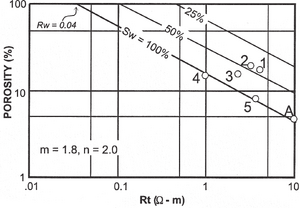Sorrento water saturation calculations
| Exploring for Oil and Gas Traps | |

| |
| Series | Treatise in Petroleum Geology |
|---|---|
| Part | Predicting the occurrence of oil and gas traps |
| Chapter | Predicting reservoir system quality and performance |
| Author | Dan J. Hartmann, Edward A. Beaumont |
| Link | Web page |
| Store | AAPG Store |
Method
Density logs were the primary source of porosity values. Matrix density appears to be about 2.68 g/cc, based on core-measured grain densities (consistent with the presumed mineralogy of the sandstones). Crosspiot porosities were not used to avoid introducing a systematic error in these variably shaly sandstones.[1]
Pickett plot
Formation-water resistivities and water saturations were estimated from Pickett plots. The inferred cementation exponent (m) is 1.8 because of the presence of clays, well-connected solution pores (e.g., [2][3] or pyrite (Kristinick, personal communication). Formation factors measured on core samples from well 1 support this interpretation.
The Pickett plot in Figure 1 shows data from well 11. The number labels represent the flow units from Figure 9-88.
Saturation exponents, n
Saturation exponents in) measured on samples from well 1 showed variations that relate to pore geometry. Microporous siltstones displayed n greater than 2, indicating either very tortuous pore systems or incomplete saturation by brine during testing. Saturation exponents were less than 2 in the best porosity type. This implies the reservoir is somewhat shaly. However, n was assumed equal to 2 for log calculations because the lab data were not far from that value and because lab measurements of saturation exponents are notoriously difficult.
See also
- Evaluation of saturation profiles
- Setting and structure of the Sorrento field
- Morrow lithofacies and pore types
- Petrophysical analysis of Sorrento field wells
- Water saturation profile for Sorrento field
References
- ↑ Patchett, J., G., Coalson, E., B., 1982, The determination of porosity in sandstone and shaly sandstone, part 2: effects of complex mineralogy and hydrocarbons: 23rd Annual SPWLA Logging Symposium, July 6–9, paper T, 50 p.
- ↑ James, S., W., 1989, Diagenetic history and reservoir characteristics of a deep Minnelusa reservoir, Hawk Point field, Powder River basin, Wyoming, in Coalson, E., B., Kaplan, S., S., Keighin, C., W., Oglesby, C., A., Robinson, J., W., eds., Petrogenesis and Petrophysics of Selected Sandstone Reservoirs of the Rocky Mountain Region: RMAG Symposium, p. 81–96.
- ↑ Muller, M., M., Coalson, E., B., 1989, Diagenetic and petrophysical variations of the Dakota sandstone, Henry field, Green River basin, Wyoming, in Coalson, E., B., Kaplan, S., S., Keighin, C., W., Oglesby, C., A., Robinson, J., W., eds., Petrogenesis and Petrophysics of Selected Sandstone Reservoirs of the Rocky Mountain Region: RMAG Symposium, p. 149–158.
